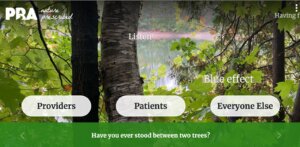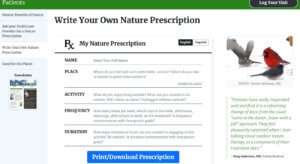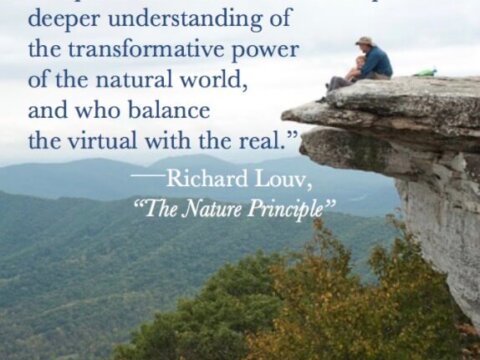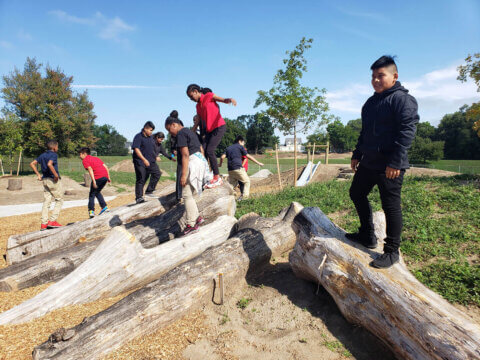Giving patients the power to self-prescribe nature
Dr. Robert Zarr wants to reimagine health care. Zarr was an early proponent of nature prescriptions, the increasingly popular phenomenon that seeks to formalize the link between nature and health. Nature prescriptions are an innovative tool for improving the health and well-being of patients, inspired by extensive scientific evidence showing how beneficial time in the outdoors can be. Rather than prescribing medication to treat ailments such as high blood pressure or depression, physicians can prescribe time in the outdoors.
Zarr explains, “There are hundreds of scientific studies that show a positive, strong correlation between time in nature and improved health outcomes.These physiological changes include a decrease in cortisol, which is a stress hormone. We can actually watch that number drop by virtue of spending more time in nature.” Zarr founded DC Park Rx — the predecessor to his current organization Park Rx America (PRA) — in 2012. He was initially inspired to pursue nature prescriptions after hearing Richard Louv, author and Children & Nature Network co-founder, speak at the American Academy of Pediatrics annual conference exhibition in San Francisco.
Since then, PRA has continued to lead the movement for nature prescriptions, offering a unique searchable online database of parks which is integrated into its prescription platform to help patients find opportunities to get outside. PRA’s database has grown over the past ten years to include over 1,400 prescribing physicians and more than 10,000 parks, with over 4,500 prescriptions issued since January 2019. But now Park Rx America is thinking even bigger.
“Physicians know us as the platform for prescribing nature — but we want to extend that capability to anyone who wants to improve their health,” Zarr says. Over the past year, the PRA prescription tool has been revamped and is now open to the public. “Our new patient portal allows the public to write their own nature prescriptions, and encourages them to work with their health care provider to maximize therapeutic potential, safely. We’re going directly to the consumer — we now have a powerful tool to engage and empower the patient.”
“What can I do to help the planet?” “Have you ever stood between two trees?” “How much fun do you have?”
– PRA website
The PRA website has also undergone a complete redesign, aiming to make it a pleasurable, peaceful place to visit — akin to the way that spending time outdoors can be a breath of fresh air. The landing page is dominated by a rotating series of soothing nature photographs, accompanied by three easy-to-navigate buttons for “Providers,” “Patients,” and “Everyone Else.” The site offers questions for reflection, such as “What can I do to help the planet?” “Have you ever stood between two trees?” and “How much fun do you have?”
The experience of writing your own nature prescription is refreshingly simple. Users are self-guided to prescribe the place, activity, frequency and duration of their time outdoors, with supportive questions like “What do you enjoy doing outside?” and “How many times per week can you commit to?” After completing the form, users can print out their prescription and bring it to their physician.

The PRA website offers a refreshing, streamlined interface for visitors. Photo courtesy of Park Rx America.
PRA’s direct-to-consumer model comes from lessons learned from other sectors in the healthcare industry throughout this past decade. “We know that the direct-to-consumer model works for big pharma,” Zarr says. In the same way that medications are advertised publicly and patients are encouraged to “ask your doctor” about a given treatment, PRA seeks to parlay the general public’s excitement around nature prescriptions into patient-provider conversations.
Prior to this, the nature prescription process flowed in one direction — PRA relied on doctors to initiate the prescription, and patients would get access to the patient-side interface only after agreeing to their doctor’s prescription. But it was hard to maintain consistency with doctors. PRA’s use of the direct-to-consumer model is a “subversive tool,” Zarr explains, “because it can be used by anyone, anywhere.”

Writing your own nature prescription is an easy way to begin the conversation with health care providers about the best ways to integrate nature into your routine. Photo courtesy of Park Rx America.
If physicians are inconsistent nature prescribers, it’s because they’re often overworked and aren’t encouraged to prioritize their own well-being. “You very seldom hear doctors talk about their own mental health,” Zarr says. “But the reality is, depression and suicide rates are higher amongst doctors than in the average population. My heart aches to know how much physicians are suffering. Doctors need to embrace self care — but that’s not part of our training or current culture.” That’s why PRA has integrated a self care section into the Provider portal on their website. There’s a lack of literature on physician health and its effects on patient outcomes, but Zarr theorizes that if physicians are healthy and happy, then that will also translate into better quality of care.
Another tool for improving physicians’ well-being? Nature, of course. To improve both physician health and patient outcomes, Zarr endorses incorporating more nature into places where people receive medical treatment. The Lone Star Family Health Center in Conroe, Texas is an example of how healthcare providers can do so while on a budget. With a grant from the National Environmental Education Foundation (NEEF) and the U.S. Forest Service, the center converted 2,500 square feet adjacent to their facility — previously a lawn — into a nature playspace with a running stream, garden, stump steppers, and more. This Nature Explore Classroom serves as a waiting room, a mental health counseling site, and a place for patients to fulfill their nature prescriptions. When it opened in 2016, it was the first certified Nature Explore Classroom located at a federally qualified health center, and several more have since followed.

Patients at Khoo Teck Puat Hospital in Singapore enjoy access to nature via outdoor walkways, abundant greenery, and many onsite gardens. Photo courtesy of iStock.com/Kandl.
Nature prescriptions and nature-filled health care sites are gaining popularity across the globe, too. In Singapore, Khoo Teck Puat Hospital (KTPH) was conceptualized as “a hospital in a garden, and a garden in a hospital” with the goal of lowering people’s blood pressure when they entered. This resulted in a design overflowing in greenery — there is a green landscape on each story, vertical “greenwalls” decorating the sides of the building, eight rooftop gardens offering organic produce and calming environs for patients, outdoor walkways between rooms, and large windows with views of greenery in each room. “When we built KTPH, we ensured that for every square meter of land we took, we added three square meters of greenery,” said Mr. Liak Teng Lit, who helped plan the hospital. In Canada, nature prescriptions often include free passes to national parks through BC Parks Foundation’s PaRX initiative.
Ultimately, Zarr wants to reimagine the health care system entirely, pivoting from a deficit-based, doctor-centric approach, to something that better encapsulates the whole patient. “If a patient leaves their visit feeling like a ‘big bag of problems,’ they won’t be inspired to follow their doctor’s orders. Instead, we are using asset framing to make the doctor’s visit a positive thing for both patient and doctor.”

Dr. Robert Zarr is using subversive tools, like an asset-based approach, to reimagine health care. Photo courtesy of Park Rx America.
This rings especially true when working with children. A pediatrician by training, Zarr believes in the power of conversation and relationships to help guide children towards healthy lifestyles. He likes to ask patients the question, “Is there a place that you like to go outside where you feel safe and comfortable?” One adolescent patient told Zarr that he has a specific “big rock” on which he likes to go and lie down. When asked why he goes there, the patient revealed that he lives in crowded housing and goes there to get some alone time. “A lot of this is about relationships and the lack of relationships. We see the prescription as a means to do that,” Zarr explains.
Zarr also draws on his experience as a nature therapy guide, certified by the Association of Nature & Forest Therapy (ANFT), to help people get grounded. During nature therapy sessions, he employs a series of invitations, the first of which is called “pleasures of presence,” during which patients are invited to touch, taste and smell, to slow down and feel. “It’s branching into mindfulness. There’s something metaphysical about this work that doctors don’t usually like to talk about,” Zarr says. ANFT‘s training and certification draws from the ancient Japanese practice of shinrin-yoku, or “forest bathing,” and Zarr incorporates the concepts and practice of forest therapy into his work of promoting nature prescriptions and physician self-care.
On the clinical side, Zarr is partnering with Dr. Deborah Cohen of Kaiser Permanente Southern California on a five-year study, funded by the National Institutes of Health, to measure the impact of nature prescriptions on 500 6- to 16-year-old patients at Unity Health Care, Inc. By following participants’ mood, behavior, and nature connectivity, they hope to provide insights into the ways that nature prescriptions can impact children’s health and well-being. Zarr and Cohen have trained participating physicians on the use of the PRA platform, and have guided them to really integrate the tool into their practice. “It’s not just ‘in addition to’,” Zarr says. “We’re not trying to get doctors to feel like they have one more thing to do — we’re trying to get them to enjoy the experience as much as for the patient.”
“We’re not trying to get doctors to feel like they have one more thing to do — we’re trying to get them to enjoy the experience as much as for the patient.”
– Dr. Robert Zarr, founder of Park Rx America
“I ask myself every day, why do I do this?” Zarr muses, then answers himself. “Everybody deserves some happiness and health. Everybody deserves a walk, everybody deserves to hug a tree. It should be a human right. Nature is the fundamental right of every child; it’s a human right. Sometimes we treat nature like a luxury, like, ‘Maybe if I have time, I’ll go for a walk.’ But it’s exactly the opposite. It’s essential to health and happiness.”
Join the Vitamin N challenge this summer!
Make your own nature prescription
Learn more about the science behind nature prescription
Research Digest: Physical health benefits of nature contact
Resources: Nature’s role in health and well-being
Resources: Nature prescription and park prescription resources
-
Feature
GROWING POWER: Urban Roots connects young people with natural spaces, food systems – and one another
-
Feature
Nature photographer Dudley Edmondson has a vision for the representation of Black and Brown faces in the outdoors
-
Network News
Community Spotlight: Prescribe Outside
-
Richard Louv
SPRING FORWARD! 12 Ways to Make Sure Your Kids (and You) Get the Right Dose of VITAMIN N this Spring — and Summer, Too
-
Voices
Placemaking: How to build kinship and inclusive park spaces for children with disabilities






